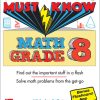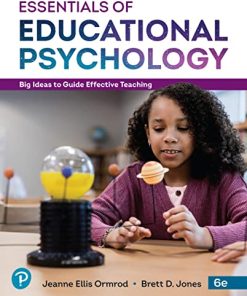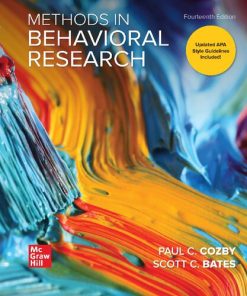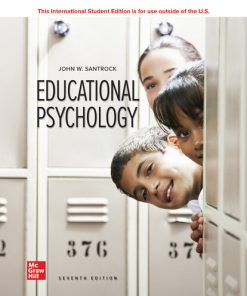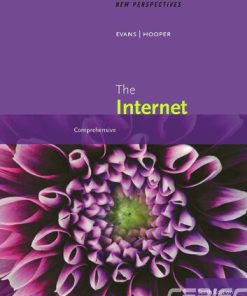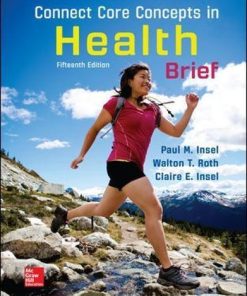(Ebook PDF) Educational Psychology Developing Learners Loose Leaf Version 9th Edition by Jeanne Ellis Ormrod, Eric Anderman, Lynley Anderman ISBN 9780134022437 0134022432 full chapters
$50.00 Original price was: $50.00.$25.00Current price is: $25.00.
(Ebook PDF) Educational Psychology Developing Learners Loose Leaf Version 9th Edition by Jeanne Ellis Ormrod, Eric Anderman, Lynley Anderman -Ebook PDF Instant Download/Delivery:9780134022437 0134022432
Instant download Full Chapter of Educational Psychology Developing Learners Loose Leaf Version 9th Edition after payment
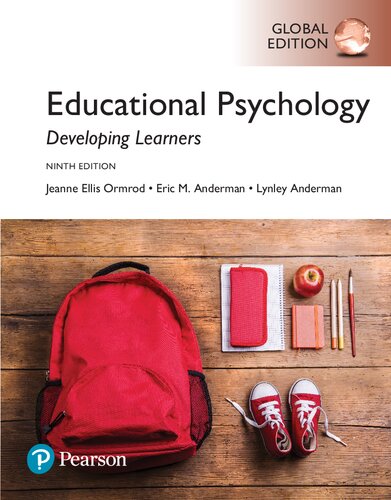
Product details:
ISBN 10:0134022432
ISBN 13:9780134022437
Author: Jeanne Ellis Ormrod; Eric M. Anderman; Lynley Anderman
Table of Contents:
- 1. Teaching and Educational Psychology
- Case Study: The “No D” Policy
- Teaching as Evidence-Based Practice
- Understanding and Interpreting Research Findings
- Quantitative Research
- Qualitative Research
- Mixed-Methods Research
- Interpreting Research Results: A Cautionary Note
- From Research to Practice: The Importance of Principles and Theories
- Collecting Data and Drawing Conclusions about Your Own Students
- Assessing Students’ Achievements and Interpreting their Classroom Behaviors
- Conducting Action Research
- Developing as a Teacher
- Strategies for Studying and Learning Effectively
- 2. Cognitive and Linguistic Development
- Case Study: Apple Tarts
- General Principles of Human Development
- The Multiple Layers of Environmental Influence: Bioecological Systems and the Importance of Culture
- Role of the Brain in Learning and Development
- Piaget’s Theory of Cognitive Development
- Piaget’s Basic Assumptions
- Piaget’s Proposed Stages of Cognitive Development
- Critiquing Piaget’s Theory
- Considering Diversity From the Perspective of Piaget’s Theory
- Contemporary Extensions and Applications of Piaget’s Theory
- Vygotsky’s Theory of Cognitive Development
- Vygotsky’s Basic Assumptions
- Critiquing Vygotsky’s Theory
- Considering Diversity from the Perspective of Vygotsky’s Theory
- Contemporary Extensions and Applications of Vygotsky’s Theory
- Contrasting Piaget’s and Vygotsky’s Theories
- Language Development
- Theoretical Issues Regarding Language Development
- Diversity in Language Development
- Second-Language Learning and English Language Learners
- 3. Personal and Social Development
- Case Study: Hidden Treasure
- Personality Development
- Temperament
- Environmental Influences on Personality Development
- The “Big Five” Personality Traits
- Temperament, Personality, and Goodness of Fit
- Development of a Sense of Self
- Factors Influencing Sense of Self
- Developmental Changes in Sense of Self
- Diversity in Sense of Self
- Development of Peer Relationships and Interpersonal Understandings
- Roles of Peers in Children’s Development
- Common Social Groups in Childhood and Adolescence
- Popularity and Social Isolation
- Social Cognition
- Aggression
- Technology and Peer Relationships
- Diversity in Peer Relationships and Social Cognition
- Promoting Healthy Peer Relationships
- Moral and Prosocial Development
- Developmental Trends in Morality and Prosocial Behavior
- Factors Influencing Moral and Prosocial Development
- Diversity in Moral and Prosocial Development
- Encouraging Moral and Prosocial Development at School
- 4. Group Differences
- Case Study: Why Jack Wasn’t in School
- Cultural and Ethnic Differences
- Navigating Different Cultures at Home and at School
- Examples of Cultural and Ethnic Diversity
- Creating a Culturally Inclusive Classroom Environment
- Gender Differences
- Research Findings Regarding Gender Differences
- Origins of Gender Differences
- Making Appropriate Accommodations for Gender Differences
- Socioeconomic Differences
- Challenges Associated with Poverty
- Fostering Resilience
- Working with Homeless Students
- Students at Risk
- Characteristics of Students at Risk
- Why Students Drop Out
- Supporting Students at Risk
- 5. Individual Differences and Special Educational Needs
- Case Study: Tim
- Intelligence
- Theoretical Perspectives of Intelligence
- Measuring Intelligence
- Nature and Nurture in the Development of Intelligence
- Cultural and Ethnic Diversity in Intelligence
- Being Smart about Intelligence and IQ Scores
- Cognitive Styles and Dispositions
- Do Students have Distinct Learning Styles?
- Does it Make Sense to Teach to Students’ “Right Brains” or “Left Brains”?
- Analytic and Holistic Thinking
- Educating Students with Special Needs in General Education Classrooms
- Public Law 94-142: Individuals with Disabilities Education Act (IDEA)
- Potential Benefits and Drawbacks of Inclusion
- Identifying Students’ Special Needs: Response to Intervention and People-First Language
- Students with Specific Cognitive or Academic Difficulties
- Learning Disabilities
- Attention-Deficit Hyperactivity Disorder (ADHD)
- Speech and Communication Disorders
- General Recommendations
- Students with Social or Behavioral Problems
- Emotional and Behavioral Disorders
- Autism Spectrum Disorders
- General Recommendations
- Students with General Delays in Cognitive and Social Functioning
- Intellectual Disabilities
- Students with Physical or Sensory Challenges
- Physical and Health Impairments
- Visual Impairments
- Hearing Loss
- General Recommendations
- Students with Advanced Cognitive Development
- Giftedness
- Considering Diversity When Identifying and Addressing Special Needs
- General Recommendations for Working with Students Who Have Special Needs
- 6. Learning, Cognition, and Memory
- Case Study: Bones
- Basic Assumptions of Cognitive Psychology
- A Model of Human Memory
- The Nature of the Sensory Register
- Moving Information to Working Memory: The Role of Attention
- The Nature of Working (Short-Term) Memory
- Moving Information to Long-Term Memory: Connecting New Information with Prior Knowledge
- The Nature of Long-Term Memory
- Learning, Memory, and the Brain
- Critiquing the Three-Component Model
- Long-Term Memory Storage
- How Knowledge Can Be Organized
- How Declarative Knowledge Is Learned
- How Procedural Knowledge Is Learned
- Roles of Prior Knowledge and Working Memory in Long-Term Memory Storage
- Encouraging a Meaningful Learning Set and Conceptual Understanding
- Using Mnemonics in the Absence of Relevant Prior Knowledge
- When Knowledge Construction Goes Awry: Addressing Learners’ Misconceptions
- Obstacles to Conceptual Change
- Promoting Conceptual Change
- Long-Term Memory Retrieval
- Factors Affecting Retrieval
- Why Learners Sometimes Forget
- Diversity in Cognitive Processes
- Facilitating Cognitive Processing in Students with Special Needs
- 7. Complex Cognitive Processes
- Case Study: Taking Over
- Metacognition and Learning Strategies
- Effective Learning Strategies
- Factors Affecting Strategy Use
- Metacognitive Strategies in the Digital Age
- Diversity, Disabilities, and Exceptional Abilities in Metacognition
- Transfer
- Factors Affecting Transfer
- Problem Solving
- Problem Encoding
- Problem-Solving Strategies: Algorithms and Heuristics
- Working Memory and Problem Solving
- Metacognition in Problem Solving
- Using Computer Technology to Teach Problem-Solving Skills
- Creativity
- Fostering Creativity
- Critical Thinking
- Fostering Critical Thinking
- Diversity in Creativity, Critical Thinking, and Other Complex Cognitive Processes
- Accommodating Students with Special Needs
- 8. Learning and Cognition in Context
- Case Study: It’s All in How You Look at Things
- Basic Assumptions of Contextual Theories
- Social Interactions as Contexts
- Interactions with More Advanced Individuals
- Interactions with Peers
- Creating a Community of Learners
- Cultures as Contexts
- Schemas, Scripts, and Worldviews as Aspects of Culture
- Communities of Practice as Aspects of Culture
- Society and Technology as Contexts
- Authentic Activities
- Technological Innovations
- Academic Content Domains as Contexts
- Literacy
- Mathematics
- Science
- Social Studies
- Taking Student Diversity into Account
- 9. Behaviorist Views of Learning
- Case Study: The Attention Getter
- Basic Assumptions of Behaviorism
- Building on Existing Stimulus–Response Associations: Classical Conditioning
- Classical Conditioning of Involuntary Emotional Responses
- Common Phenomena in Classical Conditioning
- Addressing Counterproductive Emotional Responses
- Learning from Consequences: Instrumental Conditioning
- Contrasting Classical Conditioning and Instrumental Conditioning
- The Various Forms That Reinforcement Can Take
- The Various Forms That Punishment Can Take
- Strategies for Encouraging Productive Behaviors
- Using Reinforcement Effectively
- Shaping New Behaviors
- Bringing Antecedent Stimuli and Responses into the Picture
- Strategies for Discouraging Undesirable Behaviors
- Creating Conditions for Extinction
- Cueing Inappropriate Behaviors
- Reinforcing Incompatible Behaviors
- Using Punishment When Necessary
- Addressing Especially Difficult Classroom Behaviors
- Applied Behavior Analysis
- Functional Analysis
- Positive Behavioral Interventions and Supports
- Diversity in Student Behaviors and Reactions to Consequences
- Accommodating Students with Special Needs
- 10. Social Cognitive Views of Learning
- Case Study: Parlez-Vous Français?
- Basic Assumptions of Social Cognitive Theory
- The Social Cognitive View of Reinforcement and Punishment
- Modeling
- Behaviors and Skills That Can Be Learned through Modeling
- Characteristics of Effective Models
- Essential Conditions for Successful Modeling
- Self-Efficacy
- How Self-Efficacy Affects Behavior and Cognition
- Factors in the Development of Self-Efficacy
- Teacher Self-Efficacy
- Self-Regulation
- Self-Regulated Behavior
- Self-Regulated Learning
- Self-Regulated Problem Solving
- Diversity in Self-Regulation
- Revisiting Reciprocal Causation
- Comparing Theoretical Perspectives of Learning
- 11. Motivation and Affect
- Case Study: Passing Algebra
- The Nature of Motivation
- Intrinsic versus Extrinsic Motivation
- Early Views of Basic Human Needs
- Arousal
- Cognitive and Sociocultural Factors in Motivation
- Expectancies and Values
- Interests
- Self-Determination Theory
- Diversity in Addressing Needs
- Attributions
- Goals
- Mindsets
- Diversity in Cognitive and Sociocultural Factors Affecting Motivation
- Effects of Teacher Attributions and Expectations on Students’ Motivation
- How Teacher Attributions and Expectations Affect Students’ Achievement
- A TARGETS Mnemonic for Remembering Motivational Strategies
- Affect and Its Effects
- How Affect and Motivation Are Interrelated
- Anxiety in the Classroom
- Diversity in Affect
- Motivating Students in Any Environment
- 12. Instructional Strategies
- Case Study: Westward Expansion
- General Principles That Can Guide Instruction
- Planning for Instruction
- Identifying the Goals of Instruction
- Conducting a Task Analysis
- Developing a Lesson Plan
- Creating a Class Website to Share Goals and Facilitate Communication throughout the School Year
- Teacher-Directed Instructional Strategies
- Presenting New Material through Traditional Expository Methods: Lectures and Textbooks
- Asking Questions and Giving Feedback
- Providing Practice through In-Class Assignments
- Giving Homework
- Conducting Direct Instruction
- Promoting Mastery
- Using Instructional Websites
- Using Technology to Individualize Instruction
- Learner-Directed Instructional Strategies
- Stimulating and Guiding Class Discussions
- Conducting Reciprocal Teaching Sessions
- Conducting Discovery and Inquiry Activities
- Using Technology-Based Simulations and Games
- Conducting Cooperative Learning Activities
- Structuring Peer Tutoring Sessions
- Conducting Technology-Based Collaborative Learning Activities
- Taking Instructional Goals and Student Diversity into Account
- Considering Group Differences
- Accommodating Students with Special Needs
- 13. Creating a Productive Learning Environment
- Case Study: A Contagious Situation
- Creating a Setting Conducive to Learning
- Arranging the Classroom
- Establishing and Maintaining Productive Teacher– Student Relationships
- Creating an Effective Psychological Climate
- Setting Limits
- Planning Activities That Keep Students on Task
- Monitoring What Students Are Doing
- Modifying Instructional Strategies
- Taking Developmental Differences into Account
- Taking Individual and Group Differences into Account
- Expanding the Sense of Community Beyond the Classroom
- Working with Other Faculty Members
- Working with the Community at Large
- Working with Parents
- Dealing with Misbehaviors
- Ignoring Certain Behaviors
- Cueing Students
- Discussing Problems Privately with Students
- Teaching Self-Regulation Skills
- Conferring with Parents
- Conducting Planned, Systematic Interventions
- Taking Students’ Cultural Backgrounds into Account
- Addressing Aggression and Violence at School
- A Three-Level Approach
- Addressing Gang-Related Problems
- 14. Classroom Assessment Strategies
- Case Study: The Math Test
- The Many Forms and Purposes of Assessment
- Guiding Instructional Decision Making
- Determining What Students Have Learned from Instruction
- Evaluating the Quality of Instruction
- Diagnosing Learning and Performance Problems
- Promoting Learning
- Enhancing Learning through Ongoing Assessments and Regular Feedback
- Including Students in the Assessment Process
- Using Digital Technologies in Formative Assessment
- Important Qualities of Good Assessments
- Reliability
- Standardization
- Validity
- Practicality
- Assessing Students’ Progress and Achievement Both Informally and Formally
- Informally Observing Students’ Behaviors
- Using Paper–Pencil Assessments
- Using Performance Assessments
- Additional Considerations in Formal Assessment
- Taking Student Diversity into Account in Classroom Assessments
- Accommodating Group Differences
- Accommodating Students with Special Needs
- 15. Summarizing Students’ Achievements and Abilities
- Case Study: B in History
- Summarizing the Results of a Single Assessment
- Raw Scores
- Criterion-Referenced Scores
- Norm-Referenced Scores
- Using Criterion-Referenced versus Norm-Referenced Scores in the Classroom
- Determining Final Class Grades
- Considering—Or Not Considering—Other Factors in Grading
- Including Students in the Grading Process
- Using Portfolios
- Types and Purposes of Portfolios
- Benefits and Limitations of Portfolios
- Helping Students Construct Portfolios
- Standardized Tests
- Types of Standardized Tests
- Individual versus Group Administration of Standardized Tests
- Guidelines for Choosing and Using Standardized Tests
- Interpreting Standardized Test Scores
- High-Stakes Testing and Teacher Accountability
- The U.S. No Child Left Behind Act
- Problems with High-Stakes Testing
- Productive Steps Forward in High-Stakes Testing
- Taking Student Diversity into Account
- Cultural Bias in Test Content
- Cultural and Ethnic Differences
- Language Differences and English Language Learners
- Accommodating Students with Special Needs
- Confidentiality and Communication About Assessment Results
- Communicating Assessment Results to Students and Parents
- Appendix A: Describing Associations with Correlation Coefficients
- Appendix B: Determining Reliability and Predictive Validity
- Appendix C: Matching Book and MyEdLab Content to the Praxis® Principles of Learning and Teaching Te
People also search:
educational psychology developing learners 10th edition
educational psychology developing learners 11th edition
ormrod je 2016 educational psychology developing learners pearson
educational psychology developing learners 11th edition pdf
ormrod je 2015 educational psychology developing learners pearson
Tags:
Educational Psychology,Jeanne Ellis Ormrod,Eric Anderman,Lynley Anderman,Developing Learners
You may also like…
Psychology - Social Psychology
Psychology - Pedagogy
Education Studies & Teaching - Educational Theory
Computers - Networking
New Perspectives On The Internet: Comprehensive, Loose-leaf Version 10th Edition Jessica Evans
Business & Economics - Economics
Chemistry - Organic Chemistry
Loose Leaf for Organic Chemistry with Biological Topics 6th edition Edition Smith
Business & Economics - Personal Finance


